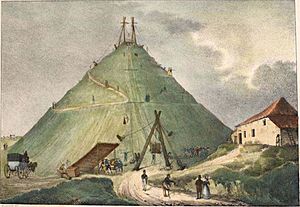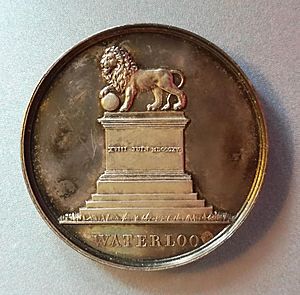Lion's Mound facts for kids

The Lion's Mound is a very large, cone-shaped hill built by people. You can find it in Braine-l'Alleud, Belgium. King William I of the Netherlands ordered it to be built in 1820. It was finished in 1826.
This special hill remembers an important event from the Battle of Waterloo. During the battle, a musket ball hit Prince William II of the Netherlands (who later became King) in the shoulder. He fell off his horse at this spot. The mound also honors the Battle of Quatre Bras, which happened two days earlier on June 16, 1815.
From the top of the mound, you get an amazing view of the battlefield. Around the mound, there are museums and places to eat. These are part of an area called the Lion's Hamlet. If you pay a small fee, you can climb the 226 steps to the top. There, you'll see the lion statue and maps of the battle. You can also use telescopes to look around. The fee also lets you see a huge painting called Waterloo Panorama.
Why Was the Mound Built?
King William I wanted a special monument. His royal architect, Charles Vander Straeten, designed it. The engineer Jean-Baptiste Vifquain helped make it happen. They wanted the mound to be a symbol of victory for all the Allied forces. It was not meant to honor just one person.
The Hill Itself
This giant man-made hill was built using earth from many parts of the battlefield. This includes fields near the La Haye Sainte farm. It also includes land from where the Duke of Wellington's army fought.
The mound is about 43 meters (141 feet) tall. Its base measures about 520 meters (1,706 feet) around.
A famous writer, Victor Hugo, wrote about the mound in his book Les Misérables. He claimed that the Duke of Wellington visited the site later. Wellington supposedly said, "They have changed my field of battle!" However, there is no proof that Wellington ever said this.
The Lion Statue
On top of the hill, there is a large statue of a lion. It stands on a stone base. Jean-Louis Van Geel sculpted the model for this lion. It looks a lot like the famous 16th-century Medici lions. The lion is a symbol of courage. You can see lions on the coats of arms for England and the Netherlands.
The lion's right front paw rests on a sphere. This sphere means global victory. The statue is very heavy, weighing about 28,000 kilograms (61,730 pounds). It is 4.45 meters (14.6 feet) tall and 4.5 meters (14.8 feet) long.
The lion was made in sections at William Cockerill's iron factory in Liège. These pieces were then brought by canal boat to Brussels. From there, strong horse-drawn carts pulled the parts to Mont-St-Jean. This is a low ridge just south of Waterloo.
There is a story that the lion was made from melted-down brass cannons. These cannons were supposedly left behind by the French army on the battlefield. But this is just a legend. In reality, the factory made nine separate iron pieces. These pieces were then put together to form the statue right at the monument site.
See also




